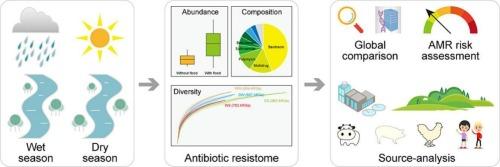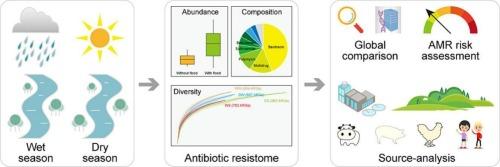污水源抗性组的增加增加了雨季河流抗生素耐药性的患病率和风险
IF 9.7
1区 环境科学与生态学
Q1 ENVIRONMENTAL SCIENCES
引用次数: 0
摘要
频繁的降雨事件会引发下水道溢流和地表径流,促进抗菌素耐药性(AMR)向下游水生环境的传播。然而,降雨期间的动态水文条件使抗生素耐药基因(ARGs)的行为复杂化,使得追踪其来源和评估相关风险具有挑战性。在此,我们综合了全球抵抗组数据,研究了湘江流域ARGs在雨季的分布、来源和AMR风险,并与旱季进行了比较。在雨季,水中和沉积物中检测到的ARGs数量分别增加了11%和9%。尽管由于河流排放的稀释,总ARG的绝对丰度和相对丰度在雨季都显著升高,表明大量的外部ARG输入。来源追踪显示,土壤在两个季节都是主要贡献者(平均61.7%),而废水来源的ARG比例在雨季显著上升(平均30.6%),并与ARG丰度呈正相关,表明废水是ARG流入的主要驱动因素。此外,河流中风险等级1和新出现的ARGs的检测增加,突显了雨季AMR风险的增加。相比之下,沉积物ARG剖面在各个季节相对稳定,雨季的ARG(平均51.0%)比旱季(65.5%)更少。高风险和新兴arg的低丰度和稀缺性表明沉积物中AMR风险很小。总体而言,我们的研究结果强调了降雨驱动的废水输入在塑造河流AMR动态中的关键作用。本文章由计算机程序翻译,如有差异,请以英文原文为准。


The increase in wastewater-sourced resistome elevated the prevalence and risk of riverine antibiotic resistance in wet season
Frequent rainfall events can trigger sewer overflows and surface runoff, facilitating the spread of antimicrobial resistance (AMR) to downstream aquatic environments. However, the dynamic hydrologic conditions during rainfalls complicate the behavior of antibiotic resistance genes (ARGs), making it challenging to trace their sources and assess associated risks. Here, we integrated global resistome data to investigate the distribution, sources, and AMR risks of ARGs in the Xiangjiang River during the wet season, in comparison to the dry season. The number of detected ARGs increased by 11% in water and 9% in sediment during the wet season. Despite dilution by river discharge, both absolute and relative abundances of total ARGs were significantly elevated during the wet season, indicating substantial external ARG inputs. Source tracking revealed that soil was the dominant contributor in both seasons (average 61.7%), while the proportion of wastewater-derived ARGs rose significantly in the wet season (average 30.6%) and positively correlated with ARG abundance, suggesting wastewater as a primary driver of ARG influx. Additionally, the increased detection of Risk Rank I and emerging ARGs in river water highlights heightened AMR risks during the wet season. In contrast, sediment ARG profiles were relatively stable across seasons, with fewer ARGs traced back to river water during the wet season (average 51.0%) compared to the dry season (65.5%). The low abundance and rarity of high-risk and emerging ARGs suggest minimal AMR risks in sediment. Overall, our findings underscore the critical role of rainfall-driven wastewater input in shaping riverine AMR dynamics.
求助全文
通过发布文献求助,成功后即可免费获取论文全文。
去求助
来源期刊

Environment International
环境科学-环境科学
CiteScore
21.90
自引率
3.40%
发文量
734
审稿时长
2.8 months
期刊介绍:
Environmental Health publishes manuscripts focusing on critical aspects of environmental and occupational medicine, including studies in toxicology and epidemiology, to illuminate the human health implications of exposure to environmental hazards. The journal adopts an open-access model and practices open peer review.
It caters to scientists and practitioners across all environmental science domains, directly or indirectly impacting human health and well-being. With a commitment to enhancing the prevention of environmentally-related health risks, Environmental Health serves as a public health journal for the community and scientists engaged in matters of public health significance concerning the environment.
 求助内容:
求助内容: 应助结果提醒方式:
应助结果提醒方式:


